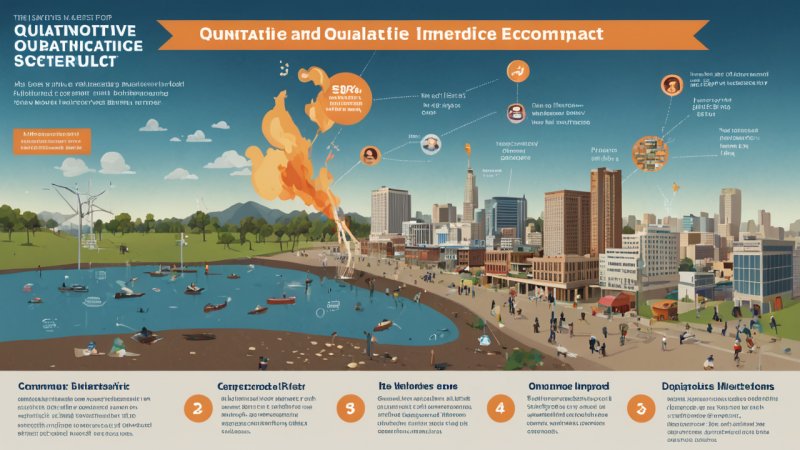Disasters, whether natural or man-made, possess a profound capability to disrupt communities, economies, and lives. Understanding the economic impact of such events is crucial for effective disaster response and recovery. Two primary approaches exist for assessing this impact: quantitative and qualitative assessments. Each approach offers unique advantages and limitations, influencing how communities can rebuild and recover after a disaster. In this article, we will delve into the nuances of both methods, comparing their effectiveness, applications, and implications for disaster relief initiatives.
Understanding Quantitative Assessments
Quantitative assessments utilize numerical data and statistical methods to measure the economic impact of disasters. This approach focuses on measurable indicators such as financial losses, employment rates, and changes in gross domestic product (GDP).
Pros of Quantitative Assessments
- Objective Data: Quantitative assessments provide objective, concrete data that can be analyzed statistically, making it easier to draw conclusions about the economic impact.
- Comparative Analysis: They allow for comparisons across different regions and time periods, helping policymakers identify trends and allocate resources effectively.
- Clear Metrics: Quantitative assessments generate clear metrics that can be communicated to stakeholders, including government agencies, NGOs, and the general public.
Cons of Quantitative Assessments
- Data Limitations: The quality of quantitative assessments heavily relies on the availability and accuracy of data, which may be challenging to obtain immediately after a disaster.
- Lack of Context: While numbers are powerful, they often lack the contextual understanding of the human experiences and social dynamics affected by disasters.
- Oversimplification: Complex social and economic impacts may be oversimplified into numbers, potentially overlooking critical factors that contribute to recovery.
Exploring Qualitative Assessments
Qualitative assessments, in contrast, focus on understanding the experiences, perceptions, and social dynamics of individuals and communities affected by disasters. This approach often employs interviews, focus groups, and case studies to gather narrative data.
Pros of Qualitative Assessments
- In-depth Insights: Qualitative assessments provide rich, detailed insights into the human experiences and emotional impacts of disasters, helping to capture the full scope of the aftermath.
- Contextual Understanding: They offer a deeper understanding of the social, cultural, and economic contexts that shape recovery efforts and outcomes.
- Flexibility: Qualitative methods can be adapted to different communities and situations, allowing for more tailored assessments based on local needs and conditions.
Cons of Qualitative Assessments
- Subjectivity: The data collected through qualitative methods can be subjective, influenced by personal biases and perspectives, which may complicate the analysis.
- Time-Consuming: Gathering qualitative data can be time-consuming, as it often requires extensive interviews and analysis of narratives.
- Difficult Comparisons: Unlike quantitative data, qualitative findings may not be easily comparable across different regions or disaster events.
Comparative Analysis of Approaches
When comparing quantitative and qualitative assessments, it becomes evident that each approach serves distinct purposes and can complement one another in understanding the economic impacts of disasters.
Data Collection
Quantitative assessments rely on numerical data obtained from surveys, government reports, and economic indicators. In contrast, qualitative assessments gather data through interviews, focus groups, and direct observations, providing a narrative that captures personal experiences.
Applicability
Quantitative assessments are particularly useful for large-scale disaster responses where data can inform resource allocation and policy decisions. Qualitative assessments shine in community-based recovery initiatives, emphasizing the importance of local knowledge and experiences.
Outcome Measurement
Quantitative assessments can produce clear metrics for measuring economic recovery, such as income levels and employment rates. Qualitative assessments, however, can reveal underlying issues that might not be captured in numerical data, such as community cohesion and mental health impacts.
Integrating Both Approaches
To achieve a comprehensive understanding of the economic impact of disasters, integrating quantitative and qualitative assessments can be highly beneficial. By combining hard data with personal narratives, stakeholders can gain a holistic view of the disaster's effects.
Case Study: Hurricane Katrina
The aftermath of Hurricane Katrina in 2005 serves as an illustrative example. Quantitative assessments highlighted the financial losses and economic downturn in the affected areas, while qualitative assessments revealed the profound social and emotional toll on communities. Together, these assessments informed recovery efforts that addressed both economic rebuilding and social support.
Conclusion
In conclusion, assessing the economic impact of disasters on communities requires a multifaceted approach that embraces both quantitative and qualitative assessments. While quantitative methods offer objective data and clear metrics, qualitative assessments provide invaluable insights into the human experiences behind the numbers. By integrating both approaches, stakeholders can develop more effective disaster response strategies that address both the economic and social dimensions of recovery. Ultimately, understanding the full impact of disasters is essential for fostering resilient communities and ensuring a sustainable recovery process.






